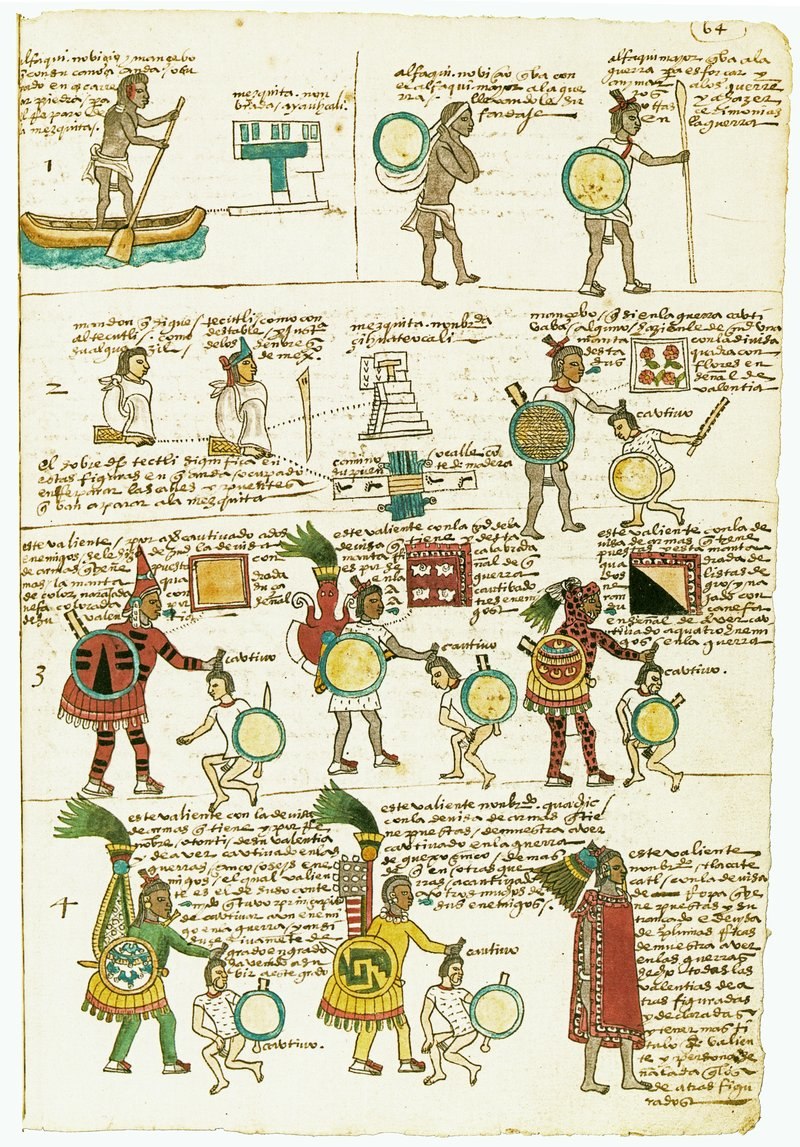Anonymous: Codex Mendoza, page 64r - various daily activities and 7 warrior scenes (1542)
(Bodleian Library, Oxford, UK)
A page from the 'Codex Mendoza', a book which was created by Indian scribes shortly after the fall of the Aztec empire. The book provides information about the conquests of the Aztec emperors, lists of tributes paid by conquered cities, daily life, uniforms of the Aztec army etc. This page is from the third part of the page which is dedicated to daily life. The page itself shows various activities of Aztec priests and an interesting list of uniforms of victorious Aztec soldiers. The text next to the pictures is Spanish and explains what is shown in the pictures. I will explain the page row for row (from top to bottom and from left to right):
First row:
- a young novice priest is transporting stones to a temple called ayauhcalli (= 'the house of Mist'), a temple dedicated to the rain god Tlaloc.
- a young and a senior priest go to war. The young priest is carrying the gear of the senior priest while the senior priest 'goes to war to encourage and inspire the warriors and perform rituals at the battlefield'
Second row:
- a noble, (recognizable by his blue diadem) and his assistent supervise the repairing of the roads and bridges which lead to the 'temple of women' (Cihuateocalli). This shrine was dedicated to the Cihuateteo (or Cihuapipiltin), the spirits of women who died in childbirth. These women were seen as valiant warriors who were slain in battle. They could however wreck havoc as they haunted crossroads at night to steal children, cause seizures and insanity, seduce men and cause them to commit adultery.
- a One-captive warrior: The taking of captives (which were ritually sacrificed later) was an very important part in Aztec warfare and the warriors were rewarded with distinctive types of uniforms, jewelry, hair styles and weapons for the amount of captives that they managed to take - these as somewhat equal to modern military ranks. This is a warrior who has captured a single warrior in battle and is rewarded with a manta, a cloak, which is decorated with flowers. The picture shows also his uniform: a simple plain shield, a macuahuitl (a wooden club with obsidian blades) and a simple quilted cotton armor.
Third row:
- a two-captive warrior: this warrior has captured two enemies and is rewarded with also a decorated cloak: this time a square orange cloak with a red border. Furthermore the warrior is allowed to wear a distinctive uniform which is known as a cuextecal costume: a red cone-shaped cap and a red/ black bodysuit and shield.
- a three captive warrior: this warrior has captured thee enemies and is rewarded with a cloak which is decorated with shells (the symbol of Ehecatl, the wind god) and a red/ white border. The uniform which the soldier is allowed to wear is a tlepapalotlahuiztli, a war-suit with a butterfly-shaped back device.
- a four-captive warrior: this warrior has captured four enemies and is rewarded with a red jaguar war-suit, the ocelotl, with a helmet, a black/ orange cloak with red decorated border. The soldier is also carrying the cuexyo shield, a famous Aztec shield design.
Fourth row:
The first two warriors each represent a rank noted for outstanding bravery and recklessness in battle
- Otomi warrior: a warrior who has captured five or six enemies. He is rewarded with a plain green bodysuit, a variation of the cuexyo shield, a xopilli (claw) back device and yellow lip- and earplugs. Also distinctive is his hairstyle which was as important as his uniform: long hair with a topknot with a red band.
- Quachic warrior: according to the text this warrior has 'captured many enemies'. This type of warriors were among the fiercest of Aztec warriors and were considered elite shock troops. Very distinctive for this warrior is his 'Quachichictli' Mohawk-like hairstyle. The warrior is wearing a plain yellow bodysuit, a pamitl back device, a xicalcoliuhqui (or 'stepped fret') shield, earplugs and a shell necklace- Tlacatecatl warrior: 'he who commands the warriors', a commanding general (he is shown later in the codex Mendoza in his uniform) and a member of the Aztec supreme council of four advisers of the Aztec emperor. Here the Tlacatecatl shown wearing a red cape with a highly decorated border. He also has a very prestigious quetzallalpiloni hair band with Quetzal feathers and a an amber and gold lip plug.
Book from around 1542.
